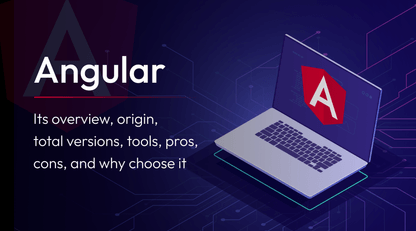With the ever-increasing demand for immersive and interactive web experiences, AngularJS has emerged as a powerful framework for developing dynamic and responsive web applications.
Boasting an extensive user base and a vast ecosystem of resources, AngularJS has revolutionized the way developers approach front-end development.
In fact, as of the latest statistics by BuiltWith, an astounding 6,235,200 websites have embraced the capabilities of AngularJS. These numbers speak volumes about the framework's effectiveness and widespread adoption.
In this informative blog, we'll delve into the world of AngularJS development, exploring its significance and the benefits it brings to building cutting-edge web applications.

From setting up your development environment to creating responsive layouts, handling user input, and optimizing performance, we'll cover it all. Whether you're new to AngularJS or want to hire dedicated developers for your new AngularJS project, this guide will equip you with the knowledge and insights needed to create exceptional web experiences.
Get ready to unlock the full potential of AngularJS as we embark on a journey to build dynamic and responsive web applications that leave a lasting impact.
Let's start by looking at how to get started with AngularJS development.
Getting Started with AngularJS Development
Before you embark on your journey to create dynamic and responsive web applications with AngularJS, it's essential to set up your development environment and establish a solid project structure.
Here we will guide you through the initial steps to ensure a smooth start.
The first crucial step in commencing your AngularJS development adventure involves setting up your development environment.
This entails the installation of necessary tools and dependencies to facilitate seamless development. Specifically, you'll need to have Node.js and npm (Node Package Manager) installed on your machine.
Once these components are up and running, you can effortlessly install AngularJS using npm. This ensures that you have all the essential elements in place to commence building dynamic and responsive web applications.
Once your development environment is established, it's time to create a meticulously organized project structure.
Having a structured project layout not only enhances the maintainability of your code but also allows for effortless collaboration and scalability.
In the realm of AngularJS, a modular approach is employed, whereby each component of the application is organized into separate modules. This modular structure fosters code reusability and facilitates the separation of concerns, resulting in a more manageable and robust application.
By acquainting yourself with the best practices of project structuring, you can lay a solid foundation for your AngularJS project and ensure its long-term success.
Now that you have a well-equipped development environment and a meticulously structured project, let's delve into the key architectural components of AngularJS.
AngularJS follows the Model-View-Controller (MVC) pattern, which segregates the application logic into distinct layers for improved organization and maintainability.
The model represents the data, the view encompasses the presentation and user interface, and the controller governs the application's behavior. A comprehensive understanding of the roles fulfilled by each component within the AngularJS architecture is pivotal for developing efficient and scalable applications.
Furthermore, AngularJS provides a wide array of built-in directives, filters, and services that augment the functionality and flexibility of your applications. These additional features empower you to enhance your development process and cater to diverse requirements.
Now, that you have a clear understanding of how you can get started, let's move forward and know how to build web applications using AngularJs that is dynamic and responsive.
Building Dynamic and Responsive Web Applications with AngularJS
Now that you have set up your AngularJS development environment and project structure, it's time to dive into the exciting realm of building dynamic and responsive web applications.
Here, we will explore the top techniques and key features of AngularJS that empower you to create engaging user experiences.
Understanding AngularJS data binding
At the heart of AngularJS lies the powerful concept of data binding, which enables real-time updates and synchronization between the model and the view.
By establishing a connection between the application's data and its presentation, you can create dynamic web applications that respond instantly to changes in data.
AngularJS supports various types of data binding, such as one-way and two-way binding, and by utilizing them effectively, you can create responsive and interactive user interfaces.
Building responsive layouts with AngularJS
Building responsive layouts is another crucial aspect of creating user-friendly web applications. With AngularJS, you have top Angular developer tools at your disposal to achieve responsive design, ensuring that your application adapts seamlessly to different screen sizes and devices.
Techniques such as media queries, flexbox, and AngularJS directives like ngClass and ngStyle enable you to create flexible and visually appealing layouts that provide an optimal user experience across various devices.
Implementing dynamic content updates
In a dynamic web application, keeping content up to date is essential. AngularJS provides mechanisms for implementing dynamic content updates, allowing you to fetch and display new data without reloading the entire page.
By mastering techniques such as asynchronous data retrieval using AngularJS services, data transformation, and manipulation with filters, as well as utilizing directives like ngRepeat to efficiently render lists and collections, you can create applications that deliver real-time updates and keep users engaged.
Handling user input and interactivity
User input and interactivity are crucial aspects of any web application, and AngularJS provides a rich set of tools for handling user interactions effortlessly.
Whether it's capturing form inputs, validating user input, or implementing event-driven functionalities, AngularJS has got you covered.
With AngularJS's form validation capabilities, you can ensure that user input is accurate and meets specified criteria, providing a seamless and error-free experience.
Furthermore, AngularJS's event-handling mechanisms allow you to respond to user actions and trigger dynamic behavior, enhancing the interactivity and responsiveness of your application.
Enhancing user experience with animations and transitions
To take your web applications to the next level, AngularJS offers a wide range of animation and transition capabilities. From subtle animations that provide visual feedback to eye-catching transitions that guide users through different sections of your application, AngularJS empowers you to create captivating user experiences.
By leveraging AngularJS's animation features, you can bring your application to life and engage your users in a visually stunning and delightful manner.
Creating dynamic components and directives
Furthermore, AngularJS allows you to create dynamic components and directives, enabling you to encapsulate complex functionalities into reusable and modular building blocks.
Components and directives enhance code reusability, maintainability, and scalability, as they can be easily plugged into different parts of your application, promoting a modular and efficient development workflow.
Optimizing performance for dynamic applications
Last but not least, optimizing the performance of your dynamic AngularJS applications is essential for delivering a smooth and responsive user experience.
AngularJS provides techniques and best practices for optimizing the performance of your application, such as lazy loading modules, using track by in ng-repeat, and leveraging the power of change detection strategies.
By applying these performance optimization techniques in Angular, you can ensure that your application performs efficiently, even with large datasets or complex interactions.
Advanced Techniques in AngularJS Development
Now that you have the understanding of the foundational concepts of AngularJS, let's explore advanced techniques that will elevate your skills and enable you to create even more sophisticated web applications.
Let’s delve into key topics that will take your AngularJS development to new heights:
Routing and navigation in AngularJS
One of the key aspects of building dynamic and responsive web applications with AngularJS is effective navigation and routing. By mastering this technique, developers can create seamless user experiences by directing users to different views and components within the application.
AngularJS offers a powerful routing mechanism that enables developers to define routes, associate them with specific components or templates, and handle navigation events.
By employing routing in AngularJS development, you can effortlessly manage complex application workflows and provide users with smooth transitions between different sections of your application.
Working with HTTP services and RESTful APIs
In today's interconnected world, integrating web applications with external data sources and APIs is crucial. AngularJS simplifies this process by providing robust support for working with HTTP services and RESTful APIs.
Leveraging these capabilities allows developers to retrieve data from remote servers, submit data, and perform various CRUD (Create, Read, Update, Delete) operations.
By harnessing AngularJS's built-in HTTP services, you can effortlessly communicate with backend servers and retrieve or send data in a standardized and efficient manner, empowering your application to interact seamlessly with external systems.
Implementing form validation and data binding
Creating forms that efficiently capture and validate user input is a fundamental requirement for many web applications.
AngularJS offers powerful form validation and data binding mechanisms, making it a breeze to implement robust and user-friendly forms. With AngularJS, developers can establish two-way data binding between the form fields and the underlying data model.
This enables automatic synchronization between the user input and the data, facilitating real-time validation and feedback to users. By skillfully implementing form validation and data binding in AngularJS, you can ensure data integrity and enhance the user experience.
Integrating third-party libraries and modules
In modern web development, leveraging existing libraries and modules can significantly speed up the development process and enhance functionality. AngularJS allows seamless integration of third-party libraries and modules into your applications.
Whether it's a charting library, a UI component framework, or a utility module, AngularJS provides a flexible architecture to incorporate external dependencies seamlessly.
Integrating third-party resources effectively, you can tap into a vast ecosystem of pre-built solutions, saving development time and effort while enriching your application's capabilities.
Read more: Identify the factors affecting the cost of hiring Angular developers.
Testing and debugging AngularJS applications
Thorough testing and debugging are critical aspects of any software development lifecycle, and AngularJS offers comprehensive tools to facilitate these processes.
With AngularJS's testing framework and debugging utilities, developers can ensure the reliability and stability of their applications.
By writing unit tests, conducting end-to-end testing, and utilizing debugging techniques, developers can identify and rectify potential issues, resulting in a more robust and error-free AngularJS application.
Final Words
Our exploration of advanced techniques and best practices for AngularJS development has equipped you with a wide array of tools and knowledge to tackle complex web application challenges.
From mastering routing and navigation to seamlessly integrating HTTP services and RESTful APIs, implementing robust form validation and data binding, leveraging third-party libraries and modules, and ensuring the quality of your applications through effective testing and debugging, you now possess the expertise to create outstanding AngularJS projects.
Whether you're a business seeking to enhance your online presence or a development team aiming to deliver cutting-edge solutions, don't hesitate to hire Angular developers who can leverage these advanced techniques to bring your vision to life.
Empower your projects with AngularJS, and witness the transformation of your web applications into powerful and dynamic experiences that captivate users.
You can hire the right dedicated developer from ThinkODC for your AngularJS project. With expertise, customer-centricity, and a commitment to excellence, ThinkODC stands as the ideal choice for your AngularJS project.
Our skilled developers create dynamic and responsive web applications, while our collaborative approach ensures your vision is realized. We prioritize quality, deliver on time, and provide comprehensive support.
Trust ThinkODC to exceed your expectations and propel your AngularJS project to success.



